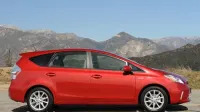2012 model year was the greenest new U.S. auto fleet ever

That’s what auto analyst Alan Baum is saying upon the release of a National Resources Defense Council (NRDC) study that shows that model-year 2012 was the greenest, MPG-wise, on record. In the US, 2012 model-year vehicles achieved an average fuel economy of 23.6 miles per gallon, up 1.1 mpg, or about five percent, from the previous record of 22.5 mpg for the 2011 model year.
And the better news is that many of the higher-MPG models weren’t compacts or subcompacts, indicating that the technology advancements automaker are using to make larger vehicles more fuel efficient is taking hold. Additionally, calendar-year 2012 will likely be the first in which Americans bought more than a half-million hybrids and electric-drive vehicles. Check out the full press release below.
Separating Fact From Fiction: Model Year and Calendar Year 2012 Are Best Ever For Greenest Vehicles
Washington, D.C. – October 31, 2012 – It’s time to give unfairly maligned green cars the respect they earned in a major way in 2012, according to auto analyst Alan L. Baum and Natural Resources Defense Council senior vehicles analyst Luke Tonachel.
“The facts are in: consumers now have more opportunities and they are indeed buying green, fuel-efficient vehicles across the market spectrum, from small cars to midsize cars, minivans, CUVs/SUVs, and pickups,” Alan L. Baum, principal of Baum & Associates, said. “They are buying cleaner vehicles that use less gas to go just as far, helping reduce America’s dependence on oil while cleaning up our air. This is an important shift that moves us toward meeting the new federal standards to increase fuel economy to the equivalent of 54.5 mpg for cars and light-duty trucks by Model Year 2025.”
Based on a new analysis released by Baum & Associates, Baum and Tonachel deflated the recent attacks in news media stories on green cars by citing the following facts:
Model year 2012 fuel efficiency for new vehicles hit an all-time high. The sales-weighted average fuel economy of new passenger vehicles for model year 2012 was 23.6 MPG, up more than 1 MPG from the previous record high of 22.5 MPG set in 2011. This was the single biggest one-year increase in MPG in the past five years. Calendar year-to-date 2012 fuel efficiency is even higher: an average of 23.8 MPG through September. (Fuel economy data is derived from the research of Michael Sivak and Brandon Schoettle (University of Michigan) at http://www.umich.edu/%7Eumtriswt/EDI_sales-weighted-mpg.html.)
Higher average fuel efficiency for model year 2012 is a good thing for the American auto industry, rather than a reflection of falling sales. Auto sales for the 2012 model year reached 14.1 million units, an increase of more than 10 percent (1.7 million) from the previous model year. In the recent past, major increases in fleet fuel efficiency were generally marked by rapid decreases in vehicle sales. For example, the three-year period from 1980 to 1982 saw increases of 3.3, 1.3 and 0.6 MPG respectively, but vehicle sales declined by 2.5 million, 750,000, and 820,000, respectively. Similarly, over the two-year period from 2007 to 2009, fleet fuel efficiency jumped 1.8 MPG, but annual vehicle sales dropped by over 5.7 million. The uncoupling of rising average MPG and falling auto sales in model year 2012 was due in large part to much wider availability of vehicles with higher fuel economy.
The number of high-MPG vehicles available to consumers is rising rapidly. Popular vehicle nameplates with improved efficiency more than doubled from model year 2009 (28) to model year 2013 (61). Fewer than a third (17) of the model year 2013 vehicles with higher MPG are compacts or subcompacts, contrary to the assumption made by many that the only high MPG cars are “small cars.”
Hybrids and plug-in electric car sales are on track to top half a million units for the first time in a calendar year (2012) and a model year (2013). This strong performance directly debunks the linked (and equally mistaken) notions that (1) consumers don’t want higher MPG vehicles and (2) there is no demand for the high-end technology that powers the highest MPG-vehicles.
Alan L. Baum, principal, Baum & Associates, said: “The just-ended 2012 model year has resulted in a record high in fuel efficiency for new vehicles. These results indicate that, contrary to some news accounts, consumers are voting with their pocketbooks and going beyond their intent to buy high MPG vehicles to making actual purchases. Furthermore, they don’t need to make compromises given the choices that are being offered. In reality, this was a banner year for the greenest cars and 2013 is shaping up to be even brighter. Plug-in electric vehicle sales are still a small niche but the number of new product offerings coming and the growing availability of these vehicles suggest that growth will continue.”
Luke Tonachel, senior vehicles analyst, Natural Resources Defense Council, said: “Those in news media stories who seek to obscure the fact that 2012 is ‘The Year of the Green Car’ are ignoring what the facts show about consumer demand for high MPG vehicles, the transformative impact of the 54.5 MPG federal fuel efficiency standards, and the major strides made by automakers to embrace and develop MPG-boosting technology advances. Those, according to press reports, who bash green cars fail to recognize that the U.S. auto marketplace has been remade in the last few years and that the old days of gas-guzzling, low MPG vehicles are, thankfully, a thing of the increasingly distant past.”
The Baum analysis is available online at http://www.baum-assoc.com/.
A related blog post from Tonachel can be found at http://switchboard.nrdc.org/blogs/ltonachel/.




